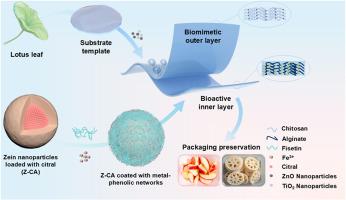Development and preservative applications of polysaccharide-based bilayer packaging films: Enhanced functional properties through metal-phenolic network-coated zein nanoparticles and biomimetic hydrophobic surfaces
IF 11
1区 农林科学
Q1 CHEMISTRY, APPLIED
引用次数: 0
Abstract
This study develops an innovative bilayer biomimetic hydrophobic film, tailored to provide a sustainable and eco-friendly packaging solution for fresh produce. The outer layer, crafted from chitosan, utilized polydimethylsiloxane templating to mimic the ultra-hydrophobic surface of a lotus leaf, achieving a water contact angle exceeding 130°. The inner layer comprised sodium alginate and zein nanoparticles, enriched with citral and fortified by a metal-phenolic network to facilitate uniform dispersion and controlled release of bioactive agents. The structural design of the film significantly improved mechanical properties, evidenced by a maximum tensile strength of 29.3 ± 3.6 MPa, and enhanced hydrophobicity, reducing water solubility to 28.3 ± 1.5% and substantially decreasing water absorption. The barrier functionality of film was also strengthened, demonstrated by a lowered water vapor transmission rate of 289.3 ± 1.5 g m−2 24 h−1, and it supported extended citral release in acidic media up to 70 h. Moreover, the film exhibited robust antioxidant and antibacterial properties. In practical tests, it effectively mitigated weight loss, browning, and hardness degradation in fresh-cut apples and lotus roots, concurrently inhibiting microbial growth and extending shelf life. This study presents an effective strategy for enhancing the hydrophobicity and bioactivity of bio-based films, contributing valuable insights to the field of sustainable food packaging.

基于多糖的双层包装膜的开发和防腐应用:通过金属酚网络包覆的玉米蛋白纳米粒子和仿生物疏水表面增强功能特性
这项研究开发了一种创新的双层仿生疏水薄膜,为新鲜农产品提供了一种可持续的环保包装解决方案。外层由壳聚糖制成,利用聚二甲基硅氧烷模板模拟荷叶的超疏水表面,使水接触角超过 130°。内层由海藻酸钠和玉米蛋白纳米颗粒组成,富含柠檬醛,并通过金属酚网络进行强化,以促进生物活性剂的均匀分散和控释。薄膜的结构设计大大改善了机械性能(最大拉伸强度为 29.3 ± 3.6 兆帕),并增强了疏水性,将水溶性降至 28.3 ± 1.5%,大大降低了吸水性。薄膜的阻隔功能也得到了增强,水蒸气透过率降低至 289.3 ± 1.5 g m-2 24 h-1 ,并支持柠檬醛在酸性介质中的释放时间延长至 70 h。在实际测试中,它有效地减轻了鲜切苹果和莲藕的重量损失、褐变和硬度下降,同时抑制了微生物的生长,延长了保质期。这项研究提出了一种增强生物基薄膜疏水性和生物活性的有效策略,为可持续食品包装领域提供了宝贵的见解。
本文章由计算机程序翻译,如有差异,请以英文原文为准。
求助全文
约1分钟内获得全文
求助全文
来源期刊

Food Hydrocolloids
工程技术-食品科技
CiteScore
19.90
自引率
14.00%
发文量
871
审稿时长
37 days
期刊介绍:
Food Hydrocolloids publishes original and innovative research focused on the characterization, functional properties, and applications of hydrocolloid materials used in food products. These hydrocolloids, defined as polysaccharides and proteins of commercial importance, are added to control aspects such as texture, stability, rheology, and sensory properties. The research's primary emphasis should be on the hydrocolloids themselves, with thorough descriptions of their source, nature, and physicochemical characteristics. Manuscripts are expected to clearly outline specific aims and objectives, include a fundamental discussion of research findings at the molecular level, and address the significance of the results. Studies on hydrocolloids in complex formulations should concentrate on their overall properties and mechanisms of action, while simple formulation development studies may not be considered for publication.
The main areas of interest are:
-Chemical and physicochemical characterisation
Thermal properties including glass transitions and conformational changes-
Rheological properties including viscosity, viscoelastic properties and gelation behaviour-
The influence on organoleptic properties-
Interfacial properties including stabilisation of dispersions, emulsions and foams-
Film forming properties with application to edible films and active packaging-
Encapsulation and controlled release of active compounds-
The influence on health including their role as dietary fibre-
Manipulation of hydrocolloid structure and functionality through chemical, biochemical and physical processes-
New hydrocolloids and hydrocolloid sources of commercial potential.
The Journal also publishes Review articles that provide an overview of the latest developments in topics of specific interest to researchers in this field of activity.
 求助内容:
求助内容: 应助结果提醒方式:
应助结果提醒方式:


